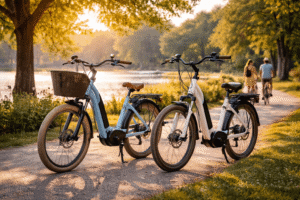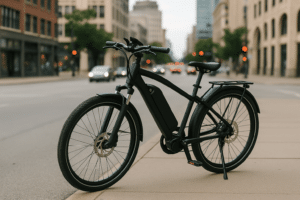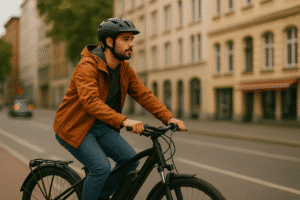In recent years, e-bikes have surged in popularity, particularly in the delivery sector. In 2022, the U.S. e-bike market was valued at a substantial USD 1.98 billion, and it’s projected to grow at a brisk 15.6% CAGR through 2030.
In this article, we’ll dive into the reasons behind this trend. We’ll explore the benefits of e-bikes for delivery, from their efficiency and cost-effectiveness to their environmental impact and beyond.
What Makes E-Bikes a Faster and More Efficient Choice for Deliveries?

The best ebike for deliveries stands out for its top features, including speed and efficiency in delivery settings. Thanks to their electric assist, they enable riders to cover distances quicker and with less effort than traditional bikes. But what else makes them a go-to choice for deliveries? Let’s break it down:
- Speed and agility: E-bikes combine the nimbleness of bicycles with the added speed from electric power. This means delivery personnel can weave through traffic, take shortcuts, and reach destinations faster.
- Less physical strain: The electric assist reduces the effort needed to pedal, especially over long distances or up hills. This means riders can maintain a consistent speed without tiring quickly, leading to more deliveries in a day.
What are the Benefits of Using E-Bike for Delivery?
E-bikes offer a range of advantages for delivery services:
1. Reduced Delivery Times
E-bikes excel in reducing delivery times, thanks to their ability to swiftly navigate through urban congestion. They can utilize bike lanes and shortcuts, bypassing traffic jams that would delay traditional vehicles.
This agility not only speeds up individual deliveries but also increases the total number of deliveries possible in a day, enhancing overall efficiency.
Additionally, the electric assist in e-bikes helps maintain a consistent speed, particularly useful when tackling hills or long routes.
This efficiency translates into better customer satisfaction and the potential for increased revenue due to quicker service.
2. Environmental Friendliness
E-bikes stand out for their zero-emission operation, making them a greener choice compared to gas-powered vehicles. In a world increasingly focused on environmental impact, using e-bikes for delivery significantly lowers a business’s carbon footprint.
Moreover, adopting e-bikes aligns with global sustainability efforts, enhancing a company’s image as an environmentally responsible entity and appealing to eco-conscious consumers.
3. Cost Savings
Operating e-bikes is more economical than traditional motor vehicles. They eliminate the need for fuel, a major expense in delivery operations, and have fewer mechanical parts, leading to lower maintenance costs.
Although the initial investment might be higher than regular bikes, the long-term savings on fuel, maintenance, and repairs are substantial, resulting in a lower total cost of ownership and a higher return on investment over the e-bike’s lifespan.
4. Health Benefits
Riding an e-bike is a form of physical activity that can improve cardiovascular health and overall fitness levels, especially beneficial for delivery personnel who spend many hours on the road.
The electric assist reduces physical strain, leading to less fatigue and exhaustion, allowing riders to work longer shifts comfortably and potentially reducing health issues associated with overexertion.
5. Accessibility and Parking Ease
E-bikes can access areas where larger vehicles might be restricted, like pedestrian zones or narrow streets, ensuring deliveries are made directly to the doorstep without hassle.
This accessibility expands the potential delivery area, allowing businesses to serve a broader customer base.
Additionally, e-bikes are easy to park almost anywhere, often closer to the delivery destination, saving time and minimizing the risk of parking fines or fees.
6. Noise Reduction
E-bikes are much quieter than motorbikes or cars, ideal for deliveries in noise-sensitive areas. This reduction in noise pollution not only benefits the environment but also enhances the quality of life in the communities served.
Using quieter e-bikes can improve a company’s image and relationship with the community, potentially increasing customer loyalty.
7. Fun to Ride
Beyond the practical advantages, e-bikes offer an often-overlooked benefit: they are simply fun to ride. The joy of zipping through streets with the wind in your hair can transform a routine delivery job into a more enjoyable experience.
This aspect of e-bike riding can have a positive impact on the morale of delivery personnel. When work feels less like a chore and more like an enjoyable activity, it can lead to increased job satisfaction, lower turnover rates, and a more positive work environment overall.
For businesses, having a team that enjoys their work can translate into better customer service and a more enthusiastic workforce. The fun factor of e-bikes, therefore, isn’t just about enjoyment; it’s a valuable component of a productive and positive workplace.
How Do E-Bikes Reduce Operational Costs for Delivery Businesses?

E-bikes are a cost-effective solution for delivery businesses. Their low operational costs stem from several factors:
- Minimal maintenance: E-bikes have fewer moving parts than motor vehicles, leading to lower maintenance costs.
- No fuel expenses: Since they’re powered by electricity, there’s no need to spend on fuel, a significant ongoing expense for traditional delivery vehicles.
- Longevity and durability: Modern e-bikes are built to last, meaning businesses can expect a longer service life with fewer replacements.
Can E-Bikes Truly Navigate Urban Traffic Better Than Cars?
Absolutely, e-bikes have a distinct advantage in urban settings. Their ability to maneuver through traffic and use bike lanes means they often get to destinations quicker than cars. Plus, the hassle of finding parking is virtually non-existent, saving precious time on each delivery.
Challenges and Considerations
While e-bikes offer numerous benefits, there are several challenges and considerations that businesses need to address:
Initial Investment
- Higher Upfront Cost: E-bikes typically have a higher initial purchase price compared to traditional bicycles. This can be a significant consideration for businesses, especially small enterprises or those looking to purchase a large fleet of e-bikes.
- Investment Justification: The cost can be justified by the long-term savings in fuel, maintenance, and increased delivery efficiency. Businesses need to evaluate their budget and potential return on investment when considering this transition.
Battery Life and Range
- Managing Battery Life: The range of an e-bike depends on its battery life, which can vary based on the model and usage. Delivery businesses need to plan routes and schedules considering the battery range to avoid mid-day recharging.
- Battery Replacement and Maintenance: Over time, batteries may need replacement, adding to the operational costs. Proper maintenance and charging practices can extend battery life, but this requires training and adherence to guidelines.
Weather Dependence
- Adverse Weather Conditions: E-bikes can be less comfortable and efficient in bad weather conditions like heavy rain or snow. This can affect delivery times and the safety of the rider.
- Mitigation Strategies: Businesses can mitigate these challenges by investing in weather-resistant gear for riders, choosing e-bikes designed for all-weather use, and adjusting delivery schedules during extreme weather conditions.
Future of E-Bike Deliveries
The future looks bright for e-bike deliveries. With advancements in battery technology and a growing focus on sustainability, we can expect e-bikes to become an even more integral part of urban delivery networks.
Conclusion
E-bikes represent a smart, efficient, and eco-friendly solution for deliveries. They offer a host of benefits, from reduced operational costs to improved delivery times.
As the market continues to grow, businesses should consider e-bikes not just as an alternative, but as a primary choice for their delivery needs.
FAQs
Yes, many electric bikes are specifically designed for delivery purposes and can handle significant loads. They often come equipped with reinforced frames, larger battery capacities, and cargo racks or baskets to accommodate heavier and bulkier items.
The range of an electric bike can vary depending on the model, battery capacity, terrain, and the weight of the load. On average, most e-bikes can cover between 25 to 70 miles on a single charge. For delivery purposes, it’s essential to choose an e-bike with a battery capacity suited to the specific delivery range requirements.
Maintenance for electric bikes is generally less frequent and less costly than for motor vehicles, but slightly more involved than for traditional bicycles. Key areas of maintenance include the battery, motor, and electrical connections. Regular check-ups can ensure the e-bike remains in good condition for reliable delivery service.
An e-bike is generally better for food delivery compared to a regular bike, primarily due to its speed and ability to cover larger distances more efficiently. The electric motor in an e-bike provides additional speed, allowing you to reach destinations faster and cover a broader area in less time.
Michael Josh is a hands-on e-bike tester and reviewer at BoltBikers, known for putting every model through real-world rides before sharing his thoughts. With a sharp eye for performance, comfort, and build quality, he helps the team choose which bikes are worth featuring. Backed by years of experience in tech and gear reviews, Michael brings trusted, honest insights to help readers find the right e-bike for their needs.








